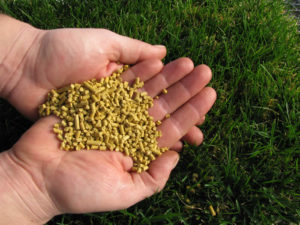
MGG’s Ryan Anderson fills you in on the natural, pre-emergent herbicide corn gluten meal and how to time its application to your lawn for best results.
About a year ago, I planned a trip to New Zealand, Hong Kong, and Thailand for the middle of June. As a cash-strapped recent Masters graduate I had every intention of purchasing the best-priced plane tickets. Research shows that flight prices start moderately high when first released and steadily decrease to their best value about 21-112 days before the flight. Book too soon and the ticket could cost up to $50 higher than the best price, purchase too late and its cost could skyrocket to $200 higher.
This window of opportunity scenario applies to corn gluten and our lawns: apply too soon and you allow the weed’s dormant seeds to dodge corn gluten’s preventative effects, too late and the weed builds resilience to corn gluten’s pre-emergent herbicidal effects.
Corn gluten, the by-product of corn processing, contains proteins that inhibit root growth during seed germination for a number of small-seeded annual and perennial weeds that frequent our lawns, including crabgrass and pigweed. Not only does this product offer a natural herbicidal alternative to toxic “weed and feed” lawn products, but it, also, contains a significant amount of nitrogen that our full-grown turf grass loves.
Applying corn gluten to established weeds, however, will only help them flourish. Corn gluten is most effective when it attacks a weed just before germination or sprouting. Generally, weed germination, specifically for crabgrass, occurs in April and we recommend applying corn gluten in the first few weeks of the month or when forsythias begin to bloom. If you wish to take a more deliberate approach to weed evasion, we recommend purchasing a soil thermometer that reaches at least four inches deep and acting once the soil temperature hits 50 degrees. Once you decide to apply, check the weather forecast and pick a time when it will not likely rain over the next few days. Wet the corn gluten with a soft spray and you are ready to start suppressing weeds!
Note that corn gluten will, also, suppress the germination of turf grass seeds, so either plant these seeds in locations away from corn gluten application or wait four to six weeks after for its herbicidal effects to wear off. You can likely find corn gluten products in the “weed n’ feed” section of your local garden center or online. Of course, you can always hire a lawn care company from our list of natural lawn care providers and ask them about their corn gluten services. For more resources, visit the Iowa State Corn Gluten Meal Research page.
